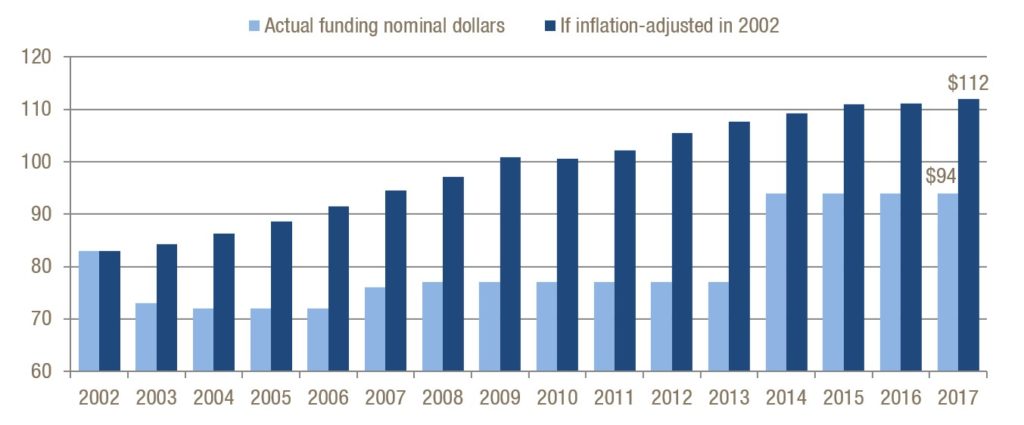State spending on Georgia’s public school students will fall behind rising costs if the General Assembly approves the funding formula proposed by Gov. Nathan Deal’s Education Reform Commission. The planned formula lacks an adjustment for inflation. It also eliminates the annual adjustment for teachers’ salaries in the current formula. The value of state spending on each student will shrink over time in the absence of these corrective adjustments and leave districts without enough resources to educate their students. State lawmakers can fix this by including an annual adjustment for inflation in the new formula.
Proposed Formula Leaves School Spending at Whim of Legislature
The commission’s recommendations, detailed in our latest report “Student Success in the Balance: Update for 2017,” say the General Assembly should annually review only the amount allotted per teacher for salary in the new formula. Legislators will then determine if that amount needs an adjustment. The commission did not recommend a process to adjust the remainder of the formula for costs that rise routinely due to inflation. Adjustments to the proposed formula will likely be infrequent and probably will not keep pace with rising costs given the Legislature’s track record of sporadic adjustments to the current funding formula.
This problem is illustrated by the infrequent adjustments to direct instructional costs allocated for each kindergartener, as calculated by today’s formula. These costs include materials such as paper, textbooks, lab equipment and replacement equipment. State spending on these things was adjusted four times, including one cut, between the 2002 and 2017 fiscal years, which began July 30th. The $93.46 allocated in the 2017 budget year for each kindergartner’s materials is higher than the dollar amount much of the past decade before taking inflation into account. But if the allotment kept pace with inflation since 2002, it would have risen to about $112. Routinely accounting for inflation also makes student funding more consistent year to year.
The importance of factoring for inflation is even starker in other categories of the funding formula, including students taking Career, Technical and Agricultural Education classes. From the 2002 to 2017 budget years, funding for each of these student’s supplies slipped from $347.50 to $341.23 for a decrease of $6.27 even before taking inflation into account. Once adjusting to reflect the rising costs of goods and services, effective spending for supplies for these students is $125 lower.
The state adjusted funding for other components of today’s formula even less frequently. The state did not adjust operations funding for elementary, middle, high and alternative schools from the 2002 budget year through 2017 to cite one example.
Lack of Inflation Adjustment Creates Underfunding of School Materials
How spending on supplies per kindergartener would change if Georgia started factoring in an inflation adjustment in 2002
New Formula Eliminates De Facto Teacher Salary Increases
The current formula does not adjust state funding for teachers’ salaries for inflation. Legislators decide when to update teachers’ salaries, which they last did in the 2009 fiscal year.
Meanwhile, today’s formula increases state funding for teachers’ salaries as they increase their years of experience or completed level of education. This acts as a kind of de facto inflation adjustment that routinely raises teacher compensation and allows districts to offer wages that approximate cost of living increases. State funding for teachers’ salaries is flat their first three years in the classroom. It increases as they gain experience or graduate degrees with annual adjustments in years four through eight and then every two years in years nine through 21, when the increases end.
The commission’s recommendations say to eliminate this adjustment starting with new teachers and instead incorporate a fixed salary amount for each teacher into the new formula’s base amount allotted to each student. That fixed amount is about $51,000, the state’s average teacher salary in the 2016 fiscal year. Districts would be required to create new compensation systems for all new teachers, which must include a measure of teacher effectiveness. The state will continue to provide funding for teachers now on staff through the existing formula. The exceptions are teachers who choose to move to their districts’ new compensation systems or ones who are moved to them by their districts.
Districts will likely find it challenging to offer competitive wages if state funding for teacher salaries is rarely increased in years ahead. That holds particularly true for school systems with low property wealth at or close to the state cap on millage rates.
The state recognizes the impact of inflation in transportation, another area vital to the state’s economic growth. In 2015 the Legislature passed a comprehensive revenue package to increase the state’s transportation spending and make critical improvements to roads and bridges. To ensure that the new revenues keep pace with rising costs, tax collections are adjusted by the Consumer Price Index for several years and in future years to account for rising fuel efficiency. A similar approach is needed to ensure that the state’s investment in students does not dwindle in the face of inflation-driven cost increases.









